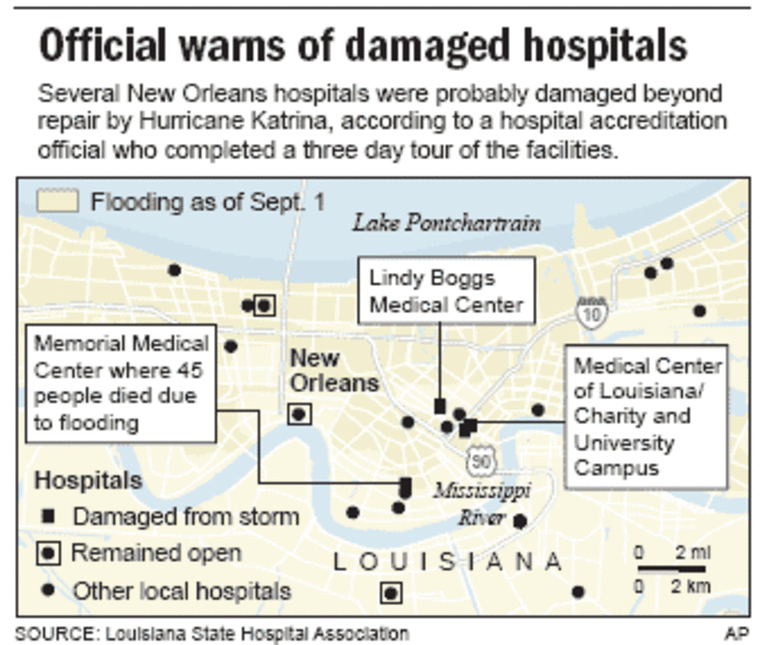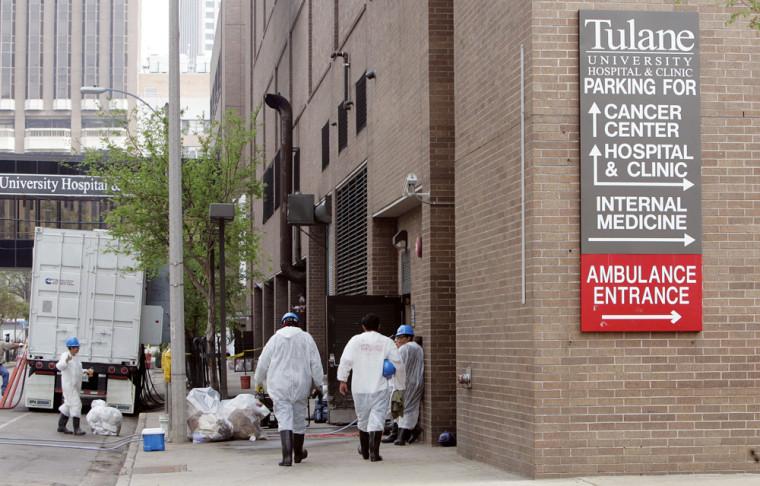This city’s health care facilities have been shattered to an extent unmatched in U.S. history, and its hospital system faces grave challenges as residents begin returning, the vice president of the national hospital accreditation organization said Sunday.
The official, Joe Cappiello, said several hospitals probably were damaged beyond repair by Hurricane Katrina, while some may try to rush back into business before conditions are safe. Others, while rebuilding, may lose doctors and nurses to communities elsewhere.
He also recounted harrowing details of how doctors and nurses felt compelled — against the fundamentals of their training — to make triage-style choices during the flood. They were forced to aid some patients at the expense of others with less chance of survival.
“Essentially the health care infrastructure of New Orleans is gone — it no longer exists,” said Cappiello, who just completed a three-day mission to the city along with a colleague from the Illinois-based Joint Commission on Accreditation of Healthcare Organizations.
Although the city has more than a dozen hospitals, none have resumed normal operations. Officials at Children’s Hospital, which Mayor Ray Nagin had hoped would be ready when residents are allowed to return to the Uptown neighborhood this week, said they may need 10 more days to prepare.
Nagin’s plan is to start repopulating the city neighborhood by neighborhood, starting Monday with the Algiers section, across the Mississippi River from downtown New Orleans. Over the next week and a half, the Garden District and the French Quarter, the city’s historic heart, are due to open to residents and businesses.
All are areas that didn’t flood, but Coast Guard Vice Adm. Thad Allen, head of the federal government’s hurricane response, has urged Nagin not to rush people back in. He didn’t want to set a timeline on Sunday, but he said the information he was getting from administrators at the U.S. Centers for Disease Control and Prevention and the Environmental Protection Agency suggested it still wasn’t safe enough.

Cappiello expressed concern that some hospitals, desperate to get back into business for competitive as well as public-service reasons, might move too quickly, before all mold and contaminants from the flooding are removed.
“I hope there’s someone looking at all the health care assets and making sound decisions as the mayor faces overwhelming political pressure to let people back in,” Cappiello said. “The federal government needs to go in there and make sure the hospitals are a safe environment before they’re reopened.”
Many local doctors and nurses are without paychecks, he said: “There’s a nationwide shortage of nurses. People will try to recruit them and many may never come back.”
He cited Charity Hospital, where floodwaters continue to be pumped out, as one that seemed beyond repair.
The hospitals seemed to have been well-prepared for Katrina’s howling winds, but not for the disastrous flooding that followed, Cappiello said. That foiled plans to evacuate critically ill patients and knocked out backup generators that would keep air conditioning and lifesaving equipment on.
At Memorial Medical Center, doctors and staff worked valiantly during the worst of the flood to evacuate more than 200 patients by boat and helicopter, but 45 patients — most of them critically ill — died at the hospital.
“We’re going to hear of a thousand more acts of heroism,” Cappiello said. “But the bottom line is that having a response plan that relies on heroism is not tenable.”
At a couple of hospitals, he said, officials ordered a lockdown of pharmaceutical supplies, wanting to protect them from looters when their hospitals emptied. They later learned that staff were unable to gain access to the drugs to aid ailing patients after flooding thwarted evacuation plans.
“Doctors and nurses who stayed behind were scrambling to find drugs for their critically ill patients,” he said. “They had to make choices that we ordinarily don’t make in America, to help those with the greatest chance of survival. ... That’s not the way we practice medicine.”
Cappiello also said he had heard unconfirmed reports that some doctors may have euthanized some critically ill patients who could not be evacuated, rather than leaving them to die from the flooding or from neglect.
“There was a whisper about that when we were down there,” he said. “It may prove to have some viability to it. Sometimes horrible decisions like that have to be made.”
The flooded areas of New Orleans continued shrinking, but crews were still searching by boat on Sunday for the dead. The state Department of Health and Hospitals said the hurricane death toll in Louisiana had risen to 646. The toll across the Gulf Coast was 883, and that number was still expected to rise.
